
The Pietà is a work of Renaissance sculpture by Michelangelo Buonarroti, housed in St. Peter's Basilica, Vatican City. It is the first of a number of works of the same theme by the artist. The statue was commissioned for the French Cardinal Jean de Bilhères, who was a representative in Rome. The sculpture, in Carrara marble, was made for the cardinal's funeral monument, but was moved to its current location, the first chapel on the north side of the entrance of the basilica, in the 18th century. It is the only piece Michelangelo ever signed. It is also the only known sculpture created by a prominent name from the Renaissance era that was installed in St. Peter's Basilica that was accepted by the Chapter of St. Peter.
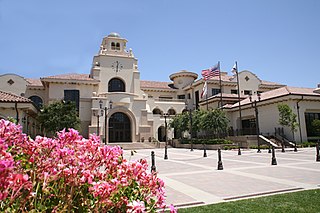
Temecula is a city in southwestern Riverside County, California, United States. The city is a tourist and resort destination, with the Temecula Valley Wine Country, Old Town Temecula, the Temecula Valley Balloon & Wine Festival, the Temecula Valley International Film Festival, championship golf courses, and resort accommodations for tourists which contribute to the city's economic profile. Although Temecula is geographically closer to downtown San Diego than downtown Los Angeles, it is considered part of the Greater Los Angeles area.
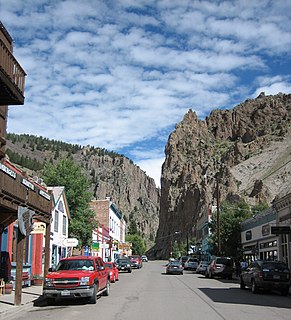
Creede is a statutory town that is the county seat of Mineral County, Colorado, United States. The town population was 290 at the 2010 United States Census.
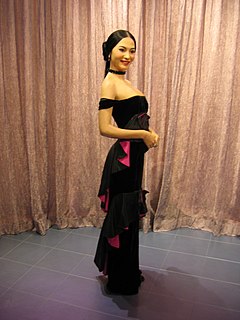
A wax museum or waxworks usually consists of a collection of wax sculptures representing famous people from history and contemporary personalities exhibited in lifelike poses, wearing real clothes.
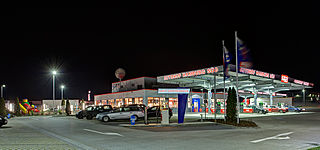
A rest area is a public facility, located next to a large thoroughfare such as a motorway, expressway, or highway, at which drivers and passengers can rest, eat, or refuel without exiting onto secondary roads. Other names include: motorway service area (UK), services (UK), travel plaza, rest stop (US), service area, rest and service area (RSA), resto, service plaza, lay-by, and service centre. Facilities may include park-like areas, fuel stations, public toilets, water fountains, restaurants, and dump and fill stations for caravans.

Wall Drug Store, often called simply Wall Drug, is a roadside attraction and tourist stop located in the town of Wall, South Dakota, adjacent to Badlands National Park. Wall Drug consists of a collection of cowboy-themed stores, including a drug store, gift shop, several restaurants, and various other stores, as well as an art gallery and an 80-foot brontosaurus sculpture. Unlike a traditional shopping mall, all the stores at Wall Drug operate under a single entity rather than being run individually. The New York Times has described Wall Drug as "a sprawling tourist attraction of international renown [that] draws some two million annual visitors to a remote town."
The Santa Margarita River which with the addition of what is now Temecula Creek, was formerly known as the Temecula River, is a short intermittent river on the Pacific coast of southern California in the United States, approximately 30.9 miles (49.7 km) long. One of the last free-flowing rivers in southern California, it drains an arid region at the southern end of the Santa Ana Mountains, in the Peninsular Ranges between Los Angeles and San Diego.

Santa Maria delle Grazie is a church and Dominican convent in Milan, northern Italy, and a UNESCO World Heritage Site. The church contains the mural of The Last Supper by Leonardo da Vinci, which is in the refectory of the convent.
The Virginia Department of Transportation (VDOT) is the agency of the state government responsible for transportation in the state of Virginia in the United States. VDOT is headquartered at the Virginia Department of Highways Building in downtown Richmond. VDOT is responsible for building, maintaining, and operating the roads, bridges, and tunnels in the commonwealth. It is overseen by the Commonwealth Transportation Board, which has the power to fund airports, seaports, rail, and public transportation.
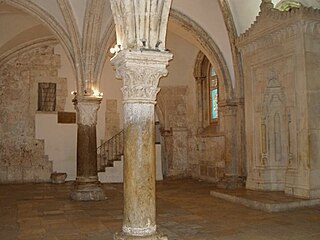
Cenacle, also known as the "Upper Room" was the first Christian church according to Catholics. Other denominations believe the first church is the Church of Saint Peter. It is a room in the David's Tomb Compound in Jerusalem, and was traditionally held to be the site of the Last Supper.
Willard Wigan, is a British sculptor from Ashmore Park Estate, Wednesfield, England, the son of Jamaican immigrants, who makes microscopic art. His sculptures are typically placed in the eye of a needle or on the head of a pin. A single sculpture can be as small as 0.005 mm (0.0002 in).
Nut Tree is a mixed-use development in Vacaville, California near the intersection of Interstate 80 and Interstate 505.

Cabazon Dinosaurs, formerly Claude Bell's Dinosaurs, is a roadside attraction in Cabazon, California, featuring two enormous, steel-and-concrete dinosaurs named Dinny the Dinosaur and Mr. Rex. Located just west of Palm Springs, the 150-foot-long (46 m) Brontosaurus and the 65-foot-tall (20 m) Tyrannosaurus rex are visible from the freeway to travelers passing by on Southern California's Interstate 10. The roadside dinosaurs are best known for their appearance in the film Pee-wee's Big Adventure (1985).

The Enchanted Highway is a collection of the world's largest scrap metal sculptures constructed at intervals along a 32-mile (51 km) stretch of two-lane highway in the southwestern part of the U.S. state of North Dakota.

Butter sculptures are sculptures carved in butter. The works often depict animals, people, buildings and other objects. They are best known as attractions at state fairs in the United States as lifesize cows and people, but can also be found on banquet tables and even small decorative butter pats. Butter carving was an ancient craft in Tibet, Babylon, Roman Britain and elsewhere. The earliest documented butter sculptures date from Europe in 1536, where they were used on banquet tables. The earliest pieces in the modern sense as public art date from ca. 1870s America, created by Caroline Shawk Brooks, a farm woman from Helena, Arkansas. The heyday of butter sculpturing was about 1890-1930, but butter sculptures are still a popular attraction at agricultural fairs, banquet tables and as decorative butter patties.
Route 15, consisting of the contiguous segments of State Route 15 and Interstate 15 (I-15), is a major north–south state highway and Interstate Highway in the U.S. state of California, connecting San Bernardino, Riverside, and San Diego Counties. The route consists of the southernmost 289.24 miles (465.49 km) of I-15, which extends north through Nevada, Arizona, Utah, Idaho, and Montana to the Canada–US border. It is a major thoroughfare for traffic between San Diego and the Inland Empire, as well as between Southern California, Las Vegas, Nevada, and the Intermountain West.
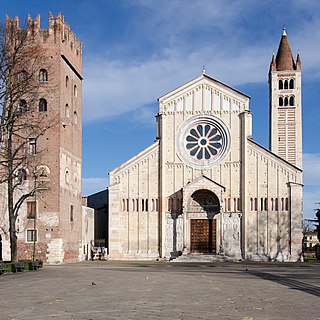
The Basilica di San Zeno is a minor basilica of Verona, Northern Italy constructed between 967-1398 AD. Its fame rests partly on its Romanesque architecture and partly upon the tradition that its crypt was the place of the marriage of Shakespeare's Romeo and Juliet. It stands adjacent to a Benedictine abbey, both dedicated to St Zeno of Verona.

Robert Isaiah Russin was an American sculptor, artist and University of Wyoming professor. He was best known for a number of public sculptures throughout the United States, including the "Spirit of Life" fountain sculpture located at the City of Hope National Medical Center in California and a giant bust of Abraham Lincoln, the Abraham Lincoln Memorial Monument, located on I-80 in Wyoming.
Willow Springs Station was a changing station at Alamos or Willow Springs along the Second Division route of the Butterfield Overland Mail, in what is now Murrieta, in Riverside County, California. It was also known as Alamos, Clines's or Kline's, or Willows, was one of the later Butterfield Overland Mail stations, placed in 1859, between some of the original stations for changing teams and providing water between stops in hot dry areas. Willow Springs, also originally known as Alamos Springs, was located west of the hills that line the east side of the Temecula Valley, on land of the Rancho Temecula, near Santa Gertrudis Creek on the low flood plain of Murrieta Creek, between Santa Gertrudis and Warm Springs Creek.
Ricardo Breceda is an artist most well known for his large metal sculptures of animals. He was born in the town of Villa Union in the state of Durango, Mexico, but now resides in Aguanga, California. He is unmarried and has two daughters, Lianna and Arabi. He originally worked as a cowboy boots salesman and a construction worker, but a construction accident caused him to leave the latter job. He made a metal sculpture of a Tyrannosaurus rex for his daughter Lianna after she asked for a dinosaur for Christmas following a viewing of Jurassic Park III.













